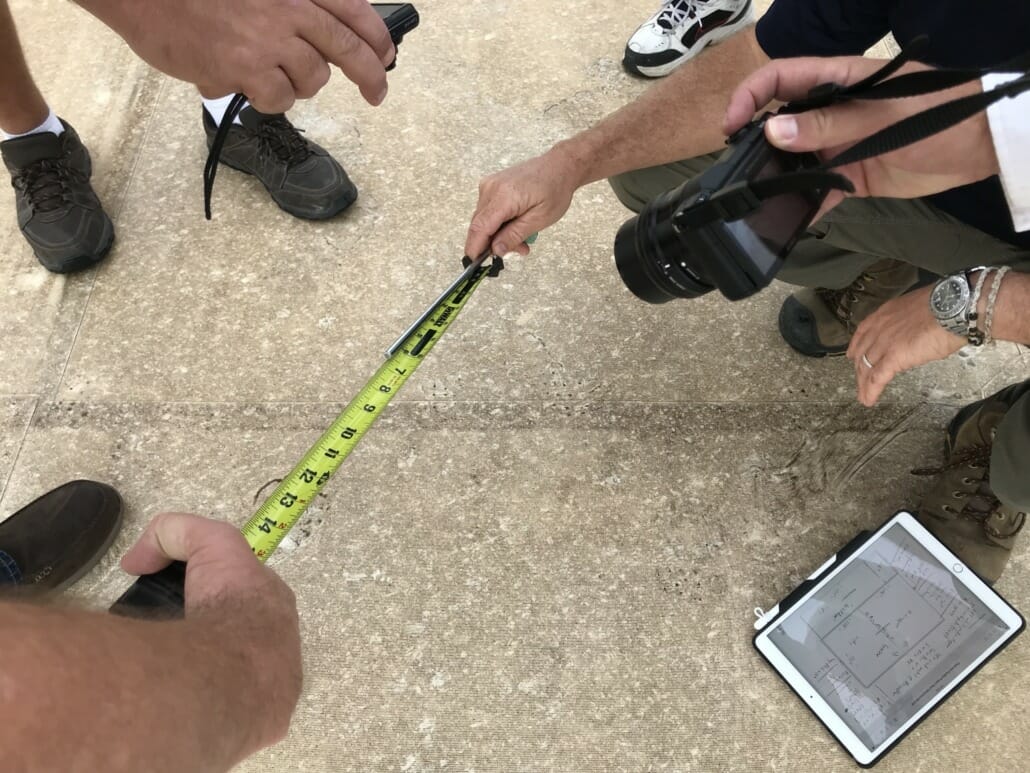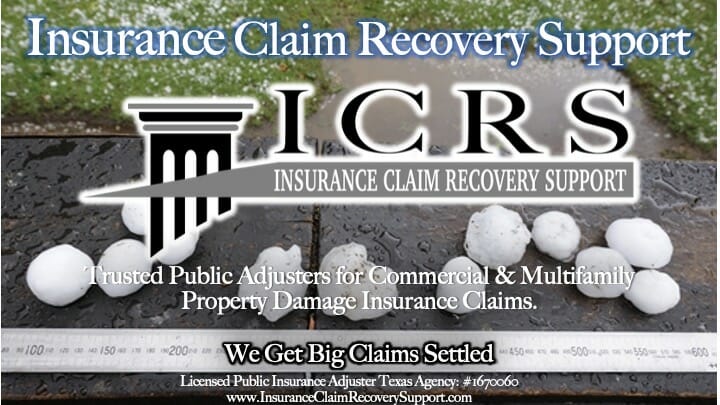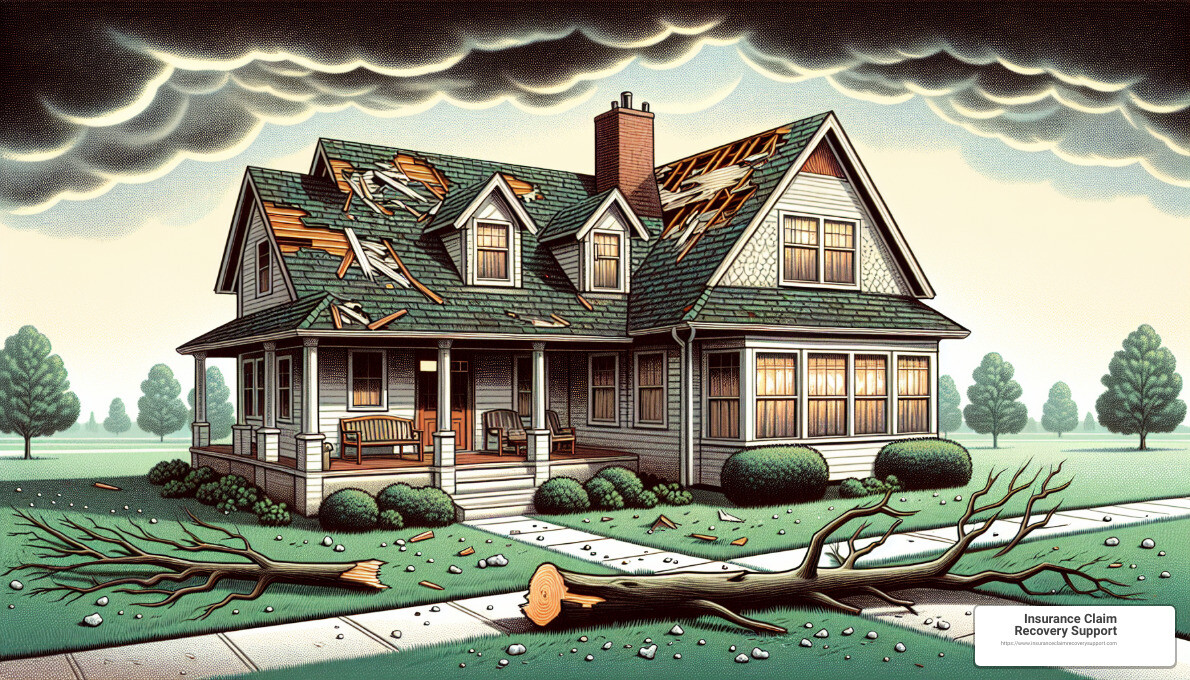When hail and wind tear through your property, the aftermath can feel overwhelming. Before the stress sets in, know that successfully filing a claim for the damage can be a straightforward process.
Let’s break it down, focusing on understanding the claims process, the importance of documenting damages, timely filing, and grasping the full impact of hail and wind damage insurance claims.
Firstly, it’s crucial to understand your insurance policy. Know what your policy covers, and check your hail and wind damage deductible to determine if the amount of your damages exceeds your actual damages. If you are unsure, ask your insurance broker.
Next up, file your claim in writing without delay. Time is critical, and delaying can complicate your claim process. Lastly, never underestimate the impact of hail and wind. What might seem superficial damage can lead to more significant issues down the road.
If you’re seeking a quick answer on how to navigate hail and wind damage insurance claims, here’s a brief guide to keep in hand:
1. Assess and document the damage immediately.
2. Review your insurance policy carefully for coverage details.
3. Report your claim promptly to avoid delays.
4. Prepare for the insurance adjuster’s visit by gathering all necessary documentation.
5. Understand your settlement options and rights as a policyholder.

Navigating through the insurance claim process after hail and wind damage doesn’t have to be a daunting task. With a clear understanding and timely action, you can ensure a smoother path to restoring your property’s condition and value.
Step 1: Assess the Damage
Safety First
Before you even think about assessing the damage, make sure it’s safe. Hail and wind can make roofs and surrounding areas dangerous. Wait until the storm passes and ensure there are no electrical hazards or unstable structures.
Documentation is Key
Grab your camera or smartphone and start taking pictures. Document every bit of damage you can find, not just on the roof but around your property too. Look for missing shingles, dents on gutters or vents, and damaged siding. If it’s related to the storm, snap a photo. The more evidence you have, the better. It’s like building a case for your claim.

Immediate Repairs
Sometimes, you can’t wait for an insurance adjuster to show up before making repairs. If there’s a risk of further damage, like a leaky roof leading to water damage inside your home, you need to act fast. Keep all receipts related to any temporary repairs you make. This includes tarps, labor, and materials. Your insurance might cover these costs and policyholders typically have a contractual duty under their policy to mitigate and prevent further damages.
Types of Damage
Understanding what constitutes hail and wind damage is crucial. Hail damage often looks like dents on metal surfaces, broken or missing pieces of roofing material, and cracked siding. Wind damage might include lifted or completely removed shingles, broken windows, and downed trees that impact your home. Each type of damage should be documented meticulously for your claim.
The initial step of assessing the damage is critical in filing hail and wind damage insurance claims. It sets the foundation for your claim and helps ensure that you’re compensated for all the repairs needed to restore your property to its pre-storm condition. For more detailed guidance on documenting and assessing storm damage, visit Insurance Claim Recovery Support.
As we move to the next steps, keep in mind that each phase is building towards maximizing your claim’s success. Proper documentation and immediate action not only protect your property from further damage but also streamline the claim process, ensuring you receive the compensation you deserve.
Step 2: Review Your Insurance Policy
Before you dive deeper into filing your hail and wind damage insurance claims, it’s critical to get cozy with your insurance policy. This document is not just a piece of paper; it’s the key to understanding what you can expect from your insurance company. Let’s break it down into simple chunks.
Coverage Specifics
First things first, what does your policy actually cover? Not all insurance policies are created equal. Some might cover the full spectrum of hail and wind damage, while others might only cover parts of it. It’s like knowing what ingredients you have before you start cooking.
Deductibles
Think of deductibles like the entry fee to a fair. It’s the amount you pay out of pocket before the insurance kicks in. Some policies have separate deductibles for hail and wind damage, especially if you live in an area where these types of storms are more common than a sunny day. Knowing your deductible is crucial because it affects how much money you’ll get in the end.
Exclusions
Insurance policies can sometimes feel like they’re written in a secret code. That’s where exclusions come in. These are the things your policy doesn’t cover. For hail and wind damage, some policies might not cover cosmetic damage, which means if the storm left your roof looking ugly but still functional, you might not see a dime.
Cosmetic Exclusions
In current insurance policies, cosmetic exclusions pertaining to hail or wind damage on roofs have become increasingly common. These exclusions typically refer to superficial damage that does not compromise the structural integrity of the roof but may affect its appearance. Examples include minor dents, scratches, or granule loss on shingles caused by hail or wind. Insurance companies often exclude coverage for these cosmetic issues to mitigate the risk of fraudulent claims and keep premiums more affordable. However, the interpretation of what constitutes cosmetic vs. functional vs. physcial damage can vary between insurers and policies, leading to potential disputes between policyholders and insurance companies. As a result, it’s crucial for homeowners to carefully review their insurance policies and understand the extent of coverage provided for roof damage caused by hail or wind.
Policy Limits
Imagine you’re at an all-you-can-eat buffet, but there’s a limit to how much you can actually eat. That’s what policy limits are. They cap the amount your insurance will pay out for a claim. Knowing your policy limits helps you set realistic expectations for your claim’s outcome.
To Wrap Up:
Before moving on to the next step in filing your hail and wind damage insurance claims, make sure you’ve got a solid grasp on your insurance policy. Knowing the ins and outs of your coverage, deductibles, exclusions, and policy limits is like having a map before you start a journey. It might seem a bit overwhelming at first, but taking the time to understand your policy now can save you a lot of headaches later. And remember, if you’re ever in doubt, reaching out to your insurance agent or a public adjuster for clarification is a smart move. For more advice on navigating the complexities of insurance claims, visit Insurance Claim Recovery Support.
As we’ve now equipped ourselves with the knowledge of what our policy entails, we’re better prepared to take on the next steps in the claim process.
Step 3: Report Your Claim
After understanding your insurance policy and assessing the damage, it’s time to officially report your claim. This step is crucial in the journey to getting your hail and wind damage insurance claims processed. Let’s simplify this process into bite-sized actions.
Contact Information:
First off, you need the right contact information for your insurance company. This might seem straightforward, but ensuring you’re reaching out to the correct department speeds up the process. Usually, this information is listed on your insurance card or the company’s website.
Claim Filing Process:
Filing a claim is more than just making a phone call. You’ll likely be directed to fill out a claim form, either online or on paper. This form is where you’ll detail the damage. The more specific you are, the better. If your insurance company has an online portal or mobile app, use it. Often, these tools are designed to make the filing process smoother and faster.
Required Documentation:
Documentation is your best friend in the claims process. Photos, videos, and a list of damaged items are essential. Include timestamps in your documentation if possible. Also, if you had to make immediate repairs to prevent further damage, keep those receipts. They’re proof of your proactive measures and might be reimbursable. A detailed roof inspection report can also significantly support your claim .
Deadlines:
Time is of the essence. Most policies require you to report damage promptly. Delaying can not only slow down the process but might also affect your claim’s validity. Check your policy for specific deadlines, and don’t procrastinate. Reporting your claim as soon as possible ensures you’re within the policy’s stipulated timeframe and can expedite the claims process.
Moving Forward
With your claim officially in the system, preparation for the next steps begins. Gathering detailed documentation and understanding your policy’s coverage has positioned you well. Now, as you await the adjuster’s visit, keep all records organized and easily accessible. The journey through hail and wind damage insurance claims might seem long, but with each step, you’re moving closer to resolution.
Clear communication and thorough documentation are your allies in this process. If any part of the process seems overwhelming, seeking assistance from professionals like Insurance Claim Recovery Support can provide the guidance you need to navigate these waters with confidence.
Step 4: Prepare for the Adjuster’s Visit
Right after you’ve reported your hail and wind damage insurance claims, getting ready for the insurance adjuster’s visit is your next big step. This visit can significantly influence how your claim is evaluated. So, let’s make sure you’re fully prepared.
Documentation is Key
First things first, gather all the evidence you’ve collected. Your photos, videos, and any notes you’ve made about the damage are crucial. The more details you provide, the clearer the extent of the damage will be to the adjuster. It’s like showing your work in math class; the answer alone isn’t enough. The adjuster needs to see how you got there.
Get Repair Estimates
Before the adjuster arrives, obtain at least two repair estimates from licensed contractors. These estimates should detail the cost to repair your home to its pre-damage condition. Why two estimates? It shows due diligence and gives you a ballpark figure to discuss during the adjuster’s visit. It’s all about being prepared and having a basis for your expectations.
List of Damages
Create a comprehensive list of everything damaged by the hail and wind. This includes personal property inside your home if affected. Don’t overlook anything because what might seem minor to you could add to the overall assessment of your claim.
Questions to Ask
Be ready with questions. Asking the right questions not only shows you’re informed but also helps clarify any uncertainties. Consider asking:
- How will the damage be assessed?
- What is the process after your visit?
- Is there anything else I need to provide or do?
These questions open up a dialogue and ensure you and the adjuster are on the same page.
The adjuster’s visit is a critical part of your hail and wind damage insurance claims process. The effort you put into preparing can make a significant difference in the outcome of your claim. So, take the time, get everything in order, and approach the visit with confidence and clarity.
For more detailed guidance on handling hail and wind damage insurance claims, visit Insurance Claim Recovery Support.
Step 5: Understand Settlement Options
When your hail and wind damage insurance claim reaches the settlement phase, you’re nearing the end of what can feel like a marathon. But it’s crucial to understand your options and the implications of the decisions you make during this stage. Let’s simplify the key points: repair vs. replacement, actual cash value vs. replacement cost, dispute resolution, and the time frame for settlement.
Repair vs. Replacement
The first decision you’ll face is whether to repair the damage or replace the affected items or parts of your property entirely. This decision often depends on the extent of the damage and the coverage your policy provides. If the damage is minor and repairable, repairing might be the way to go. However, for extensive damage, replacement might be necessary to restore the property to its pre-loss condition.
Actual Cash Value vs. Replacement Cost
Understanding the difference between actual cash value (ACV) and replacement cost is vital. ACV takes depreciation into account, meaning you’ll get the value of the item at the time of loss, not what you paid originally. On the other hand, replacement cost policies provide you with the amount needed to replace the item with a new one of similar kind and quality.
If your policy covers replacement cost, you might need to initially cover the cost of replacement out-of-pocket before being reimbursed by your insurance company. It’s important to know how many months you’re allowed from the date of the cash value payment to replace the items and collect the full replacement cost .
Before You Have a Problem…
One of the most frequently asked questions we get is, “When should I hire a public adjuster?” Click here to watch our 2 minute answer.
Dispute Resolution
Disagreements over the settlement amount can arise. If you believe the settlement offer is too low or unfair, you have the right to dispute it. Start by discussing your concerns with your insurance company. If you’re unable to reach a satisfactory agreement, consider hiring a professional like a public adjuster who can negotiate on your behalf.
Time Frame for Settlement
Insurance companies generally have a time frame within which they are supposed to settle claims. This varies by state and policy, so check your policy or consult with a professional if you’re unsure. Being aware of these time frames can help ensure that you’re not left waiting indefinitely for your settlement.
Understanding these aspects of the settlement process ensures that you make informed decisions that align with your best interests. If you’re ever in doubt, seek professional guidance to navigate through these choices. Insurance Claim Recovery Support can offer expertise and support through every step of your hail and wind damage insurance claim, ensuring you get the settlement you deserve.
Navigating through hail and wind damage insurance claims can be complex, but knowing your settlement options simplifies the process, bringing you closer to restoring your property and moving forward.
Navigating Challenges in Claims
When it comes to hail and wind damage insurance claims, it’s not always a straight path to getting your settlement. Sometimes, you might hit a few bumps along the way. Let’s talk about some common challenges like denied claims, underpayment, delays, and the appraisal process, and how to navigate through them.
Denied Claims
One of the first hurdles you might face is having your claim denied. This can happen for several reasons:
- Damage not meeting the deductible: Your insurance policy has a deductible, the amount you need to pay before insurance kicks in. If the repair cost is less, they won’t cover it.
- Pre-existing damage: If the insurer believes the damage was already there before the hail or wind event, they might deny your claim.
- Failure to maintain the roof: Not keeping your roof in good shape can lead to a denial.
It’s crucial to understand why your claim was denied. Sometimes, it’s a matter of providing more information or correcting a misunderstanding.
Underpayment
Another challenge is underpayment, where the insurance company offers less than what you believe the repair costs will be. This might happen due to excessive depreciation or using outdated price lists to estimate repair costs. If you’re faced with underpayment, it’s important to have detailed repair estimates from licensed contractors to back up your claim .
Delays
Delays in processing your claim can be frustrating. Insurance companies might use various tactics to delay your claim, hoping you’ll accept a lower settlement. Being persistent and following up regularly can help move things along. Keeping detailed records of all communications can also be beneficial.
Appraisal Process
If your claim is denied or underpaid, most insurance policies have an appraisal clause. It’s important to review your policy to understand this process and the deadlines involved. During the appraisal, you can provide additional documentation or evidence to support your claim. This might include more detailed repair estimates, photos of the damage, or reports from public adjusters.
Navigating these challenges can be daunting, but you don’t have to do it alone. A public adjuster can be a valuable ally, helping you understand your policy, gathering the necessary documentation, and negotiating with the insurance company on your behalf. The goal is to get the fair settlement you deserve for your hail and wind damage insurance claims.
Keep these tips in mind, and don’t hesitate to seek professional help if you’re facing challenges with your claim. With the right approach and support, you can navigate these challenges successfully and ensure that your property is restored to its pre-damage condition.
Conclusion
Filing hail and wind damage insurance claims can be a complex process. To ensure you get the maximum compensation you deserve, approach each step with thoroughness and precision. Here’s how you can maximize your claim:
- Document everything meticulously from the start. Photos, repair estimates, and detailed notes can be invaluable.
- Understand your policy fully. Knowing the ins and outs of what’s covered and what’s not can save you from surprises down the line.
- Meet all deadlines and follow up regularly. Insurance companies can have many claims to process, and you don’t want yours to fall through the cracks.
Importance of Professional Help
Navigating the intricacies of insurance claims can be daunting. This is where professional help can make a significant difference. Experts like Insurance Claim Recovery Support LLC specialize in advocating for policyholders. They’re equipped with the knowledge and experience to:
- Assess and document damage comprehensively.
- Navigate the complex language of insurance policies.
- Negotiate effectively with insurance companies.
Their expertise can be the difference between a claim that barely covers the damage and one that fully compensates you for your losses.
Insurance Claim Recovery Support LLC
Insurance Claim Recovery Support LLC is your partner in navigating hail and wind damage insurance claims. Our track record of success stories speaks to our commitment to fighting for policyholders’ rights. With a tailored approach to each claim, we ensure that every client gets the personalized strategy they need to achieve a fair settlement.
In conclusion, while the aftermath of hail or wind damage can be stressful, you don’t have to face it alone. With the right preparation and professional support, you can turn a daunting situation into a manageable one. Insurance Claim Recovery Support LLC stands ready to guide you every step of the way, ensuring you get the fair settlement you rightfully deserve.
Frequently Asked Questions about Hail and Wind Damage Insurance Claims
Navigating through hail and wind damage insurance claims can sometimes feel like you’re trying to solve a puzzle without all the pieces. We’ve gathered some common questions to help put those pieces together, making your journey smoother and more understandable.
What is the difference between actual cash value and replacement cost?
Let’s break this down simply:
- Actual Cash Value (ACV): Think of ACV as the “used price” for your roof or property. It’s what your roof is worth today, considering its age and wear. If your roof was 10 years old, the insurance company would pay you for what a 10-year-old roof is worth today, not what you initially paid.
- Replacement Cost Value (RCV): This is like hitting the reset button. RCV covers the cost of replacing your damaged roof with a new one, regardless of your old roof’s age or condition. It doesn’t factor in depreciation.
The difference between these two can significantly impact your pocket, so understanding which one your policy offers is crucial. 
How can I ensure my claim is processed quickly?
Speed is of the essence when dealing with hail and wind damage. Here are a few tips to help speed up the process:
- Document everything: As soon as it’s safe, take photos or videos of the damage. The more evidence you have, the better.
- Report promptly: Don’t wait. Contact your insurance company as soon as possible to get the ball rolling.
- Be detailed: When you file your claim, provide as much information and documentation as possible.
- Stay organized: Keep a record of all your communications with the insurance company, including dates, names, and what was discussed.
Being proactive and prepared can make a big difference in how swiftly your claim is processed. 
What should I do if my claim is denied?
First off, don’t panic. Here are your next steps:
- Understand why: Insurers should provide a reason for the denial. Knowing why can guide your next steps.
- Review your policy: Sometimes claims are denied because of a misunderstanding of the policy terms. Double-check your coverage.
- Gather more evidence: If you disagree with the denial, collect more documentation or evidence that supports your claim.
- Appraisal: You have the right to invoke appraisal. This is where having detailed documentation and possibly expert opinions can bolster your claim for damages.
- Consider professional help: This might be the time to get a public adjuster or legal advice, especially if a significant amount is at stake.
A denial isn’t the end of the road. There are steps you can take to contest the decision. For more detailed guidance on handling denied or underpaid claims, visit Insurance Claim Recovery Support.
Facing hail and wind damage claims can be overwhelming, but being equipped with the right information and questions can empower you to navigate the process more smoothly. And remember, professional help is always available to guide you through this journey, ensuring you get the compensation you deserve.









